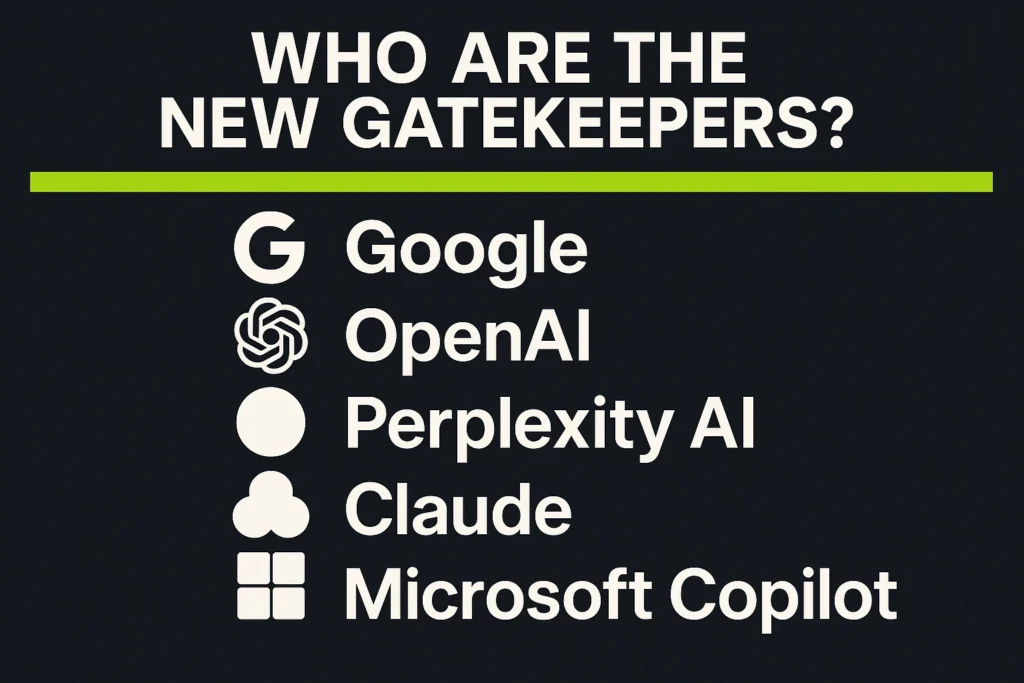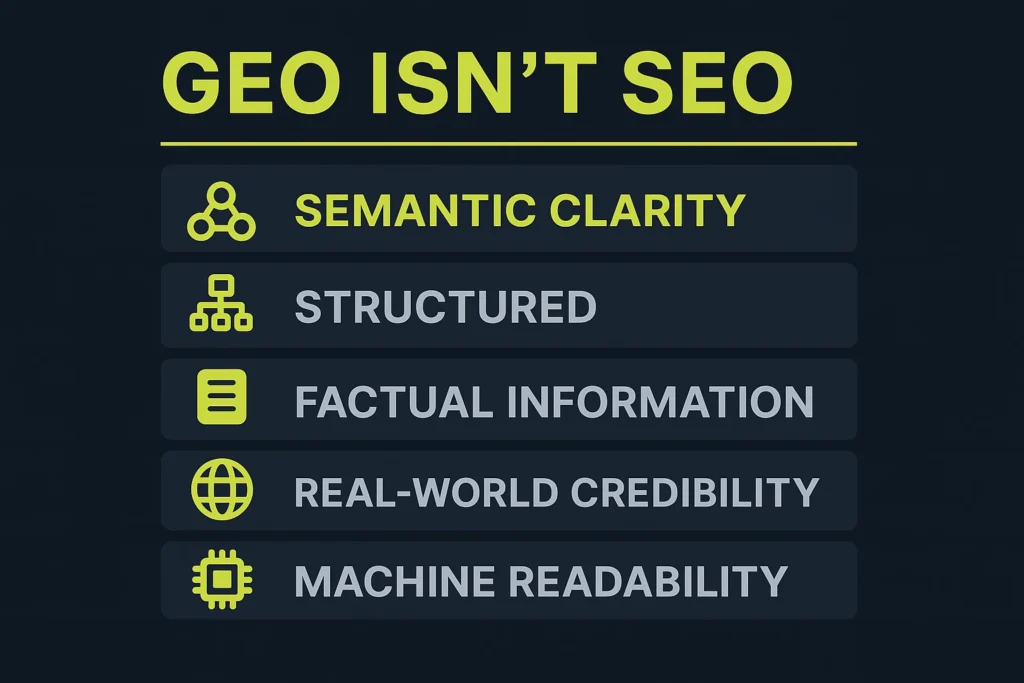Search isn’t what it used to be. It’s not just about keywords or rankings anymore – it’s about showing up in the answer. AI tools like ChatGPT, Google’s SGE, and Perplexity aren’t just changing how people search; they’re changing who gets seen. And that shift has cracked open a new layer of visibility rules, with GEO (Generative Engine Optimization) at the center of it.
If your brand isn’t already showing up in AI-generated summaries, it might not be showing up at all. Let’s unpack what that means, who the new gatekeepers are, and how to get ahead before the window closes.
So, What Is GEO Really?
GEO stands for Generative Engine Optimization. It’s not just a spin on SEO with a fresh coat of AI paint. It’s a fundamental rethink of how visibility works in a world where people interact with large language models (LLMs) instead of search engines.
The premise is simple but powerful: you’re no longer optimizing for rank – you’re optimizing to be cited, summarized, and included in the AI-generated response. Whether someone’s asking ChatGPT for the best productivity apps or using Google’s AI Mode to compare eCommerce platforms, your content needs to show up in the generated output. Otherwise, it might never be seen at all.
The New Discovery Layer
Traditional search relied on crawlers, indexes, and human clicks. GEO sits on top of that, inside the responses themselves. Instead of offering ten links, an AI tool might return a four-paragraph summary. If your brand isn’t in those four paragraphs, you’re invisible.
Unlike the classic search model, where position #1 meant dominance, visibility now comes from being referenced, not necessarily being ranked. That creates an entirely different dynamic for marketers and content creators.
This new discovery layer spans across:
- Chat interfaces like ChatGPT, Claude, and Poe.
- Integrated search tools like Google’s AI Overviews or Bing Copilot.
- Real-time answer engines like Perplexity AI.
- Enterprise software that uses LLMs to retrieve internal or web content.
In this ecosystem, getting discovered requires more than metadata and backlinks.

Who Are the New Gatekeepers?
Let’s break down the players that are now shaping what gets seen and what doesn’t:
Google (AI Overviews and AI Mode)
Google is still the giant in the room. But its recent pivot to AI-first experiences changes the stakes entirely. AI Overviews now appear in over half of all searches. They synthesize responses directly from content on the web and present a clickable-free experience.
AI Mode, rolled a bit later, replaces the entire search experience with a conversational model. Instead of clicking through listings, users just talk to the AI and get answers on the fly. Outbound clicks have dropped dramatically. SimilarWeb data shows fewer than 4% of users in AI Mode actually click to external sites.
So the visibility game has changed. More impressions, fewer visits.
OpenAI (ChatGPT)
ChatGPT isn’t technically a search engine, but it’s where millions now go for recommendations, answers, and research. It doesn’t just pull data from the open web – it interprets, rewrites, and summarizes.
With over 800 million weekly users and integrations across Microsoft apps, iOS, Android, and the web, ChatGPT is one of the most important new discovery surfaces.
If your content isn’t:
- Clear and easy to parse.
- Authoritative and trustworthy.
- Structured with headers, lists, and semantic clarity.
…then it probably won’t get used, even if it’s technically correct.
Perplexity AI
Perplexity operates like an answer engine rather than a chatbot. It’s fast, accurate, and transparent. One of its most notable features: every response includes citations to source content.
That makes it a double-edged sword. On the one hand, smaller brands can get visibility without needing to win top spots on Google. On the other hand, if your content lacks depth or structure, you’re simply left out.
Perplexity rewards:
- Real-time crawlable content.
- Credibility and clear authorship.
- Well-structured explanations.
Claude (Anthropic)
Claude focuses on helpfulness, harmlessness, and honesty. It’s used mostly in enterprise and professional contexts, with strong adoption in Slack and productivity tools.
For GEO, Claude is a reminder that factual accuracy and ethical framing matter. If your content is manipulative, biased, or vague, it won’t make it through Claude’s filters.
Microsoft Copilot
By embedding generative AI into Word, Excel, Outlook, and Bing, Microsoft has quietly woven itself into millions of workflows. While Bing’s overall market share is modest (around 4%), Copilot rides on top of Windows and Microsoft 365’s huge user base.
If your content answers common user queries in work contexts – like summarizing reports or comparing products – Copilot can surface it. But again, it favors clarity, authority, and structured sources.

GEO isn’t SEO with a new name
There’s a common misconception that GEO is just SEO 2.0. It’s not. It’s a different game with a different scoreboard. Here’s how they diverge.
Traditional SEO Priorities:
- Keyword targeting.
- Link building.
- Title tags and meta descriptions.
- Crawlability and page speed.
GEO Priorities:
- Semantic clarity.
- Structured formats (FAQs, guides, explainers).
- Factual, verifiable information.
- Real-world credibility (press, reviews, citations).
- Machine readability (schema, clean HTML, headings).
It’s not about gaming the algorithm. It’s about becoming a reliable part of the model’s knowledge base.
How Visibility Works Now
When someone asks ChatGPT a question, it doesn’t just scrape Google. It consults what it “knows” – its training data, plugins, and live web access. If your brand isn’t part of that picture, you’re not part of the answer.
Visibility is no longer: “Are we on page one?”. It’s now: “Does the AI mention us when someone asks about our category?”.
This calls for a mindset shift. You’re not writing for crawlers anymore. You’re training models.
Key Actions to Take Now
Getting serious about GEO means changing how you produce and distribute content.
Here are tactical steps that matter right now:
- Audit your brand: Ask AI tools about your company. See what shows up, what doesn’t, and what’s wrong.
- Fix the gaps: Add structured explainers, FAQs, and clean product pages. These are model-friendly.
- Secure high-authority mentions: PR, guest posts, podcasts – they’re not just visibility plays. They become part of the model’s training data.
- Use semantic structure: Headings, lists, and schema help AI extract meaning quickly.
- Fact-check your content: Misinformation gets ignored or filtered out.
The PR x SEO hybrid
One of the most important changes in the GEO landscape is how earned media works. A single quote in a credible outlet can carry more weight in AI summaries than ten well-optimized blog posts.
That means PR, reputation, and digital content strategy are converging.
To compete in the GEO era:
- Think like a journalist and an engineer.
- Write for people, format for machines.
- Structure your narrative, then let others cite it.
Discovery Happens Everywhere
We’re not in a world of 10 blue links anymore. We’re in a world where answers live inside:
- Summaries on the search results page.
- Chat interfaces that never link out.
- Productivity apps that auto-generate content.
- Internal search tools that rely on LLMs.
So whether someone is researching your product, comparing services, or trying to solve a problem, the window to influence them is much narrower.
You’re not trying to get clicked. You’re trying to be included.

How We Approach This at Nuoptima
At Nuoptima, we’ve seen this shift coming for a while. That’s why we didn’t just double down on traditional SEO tactics – we evolved with the landscape. GEO is already baked into our strategy, from the way we build content architectures to how we engineer relevance across AI discovery surfaces.
We treat visibility as a system, not a gamble. Our content isn’t just optimized for search engines – it’s structured to be recognized, interpreted, and trusted by generative models. Whether we’re writing SEO landing pages, producing multilingual content, or building high-authority backlink profiles, everything feeds into discoverability where it matters most: inside the answers.
This isn’t theoretical for us. It’s already how we drive sales and scale growth for our clients. GEO isn’t just the future – it’s the foundation we build on.
To Sum Up
The GEO landscape isn’t theoretical. It’s here. And the brands that take it seriously today are going to own the AI-generated conversations of tomorrow.
This isn’t just an SEO update. It’s a rewriting of how visibility works. And while the tools are evolving quickly, the core principle is already clear:
If you’re not part of the answer, you might not even be in the game.
Adapt accordingly.
FAQ
Not quite. SEO is about ranking in search engines. GEO is about showing up in the answer. Think of it as the difference between being a clickable link and being part of the story the AI tells. Same goal – visibility – but totally different mechanics.
The easiest way is to ask them. Literally. Ask ChatGPT, Perplexity, or Google’s AI Overviews about your product, service, or industry. If you don’t show up or worse, if the answer is wrong, you’ve got work to do.
Content that’s clear, structured, and trustworthy. FAQs, explainers, well-formatted guides, and anything with real-world credibility behind it. Think less about clever hooks and more about useful, verifiable answers.
Yes, but not in the same way. It’s less about building domain authority and more about being cited by reputable sources. A high-quality mention in a trusted outlet can train a model faster than a hundred low-value backlinks.
Absolutely. AI doesn’t just favor size, it favors clarity and relevance. If your content is well-written, well-structured, and focused on helping users, you can punch way above your weight.
More often than you think. Many AI systems pull from live web data or recent sources, especially tools like Perplexity. If your content’s outdated or stale, it’s easy to get skipped in favor of something fresher.



